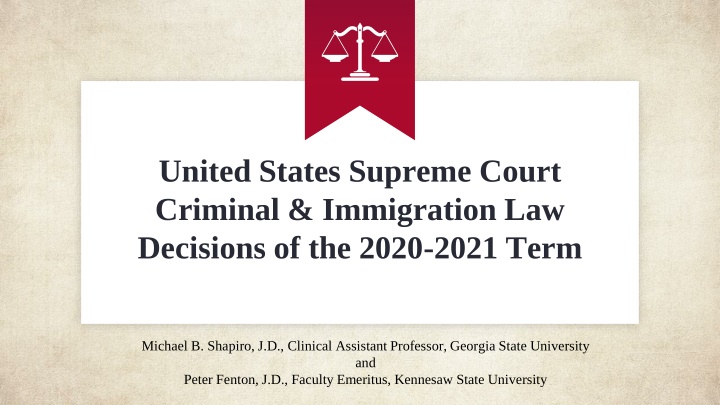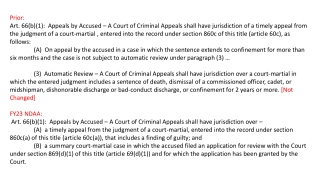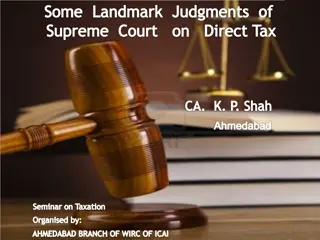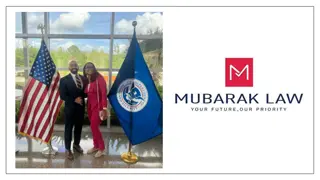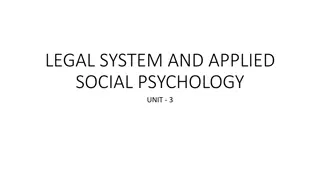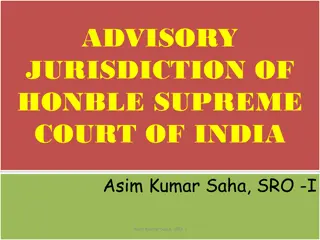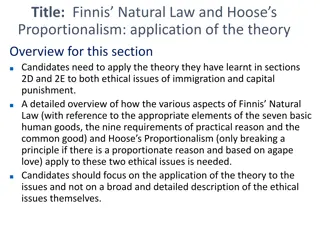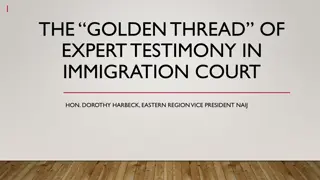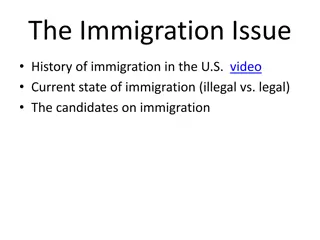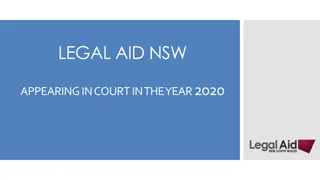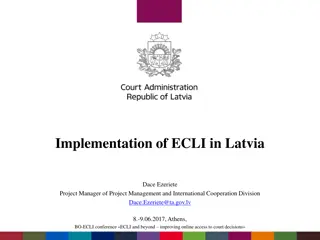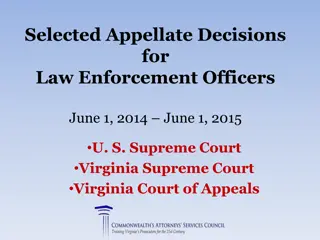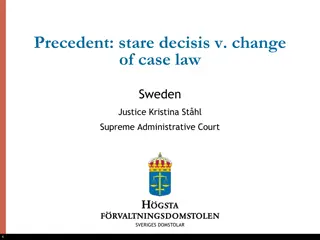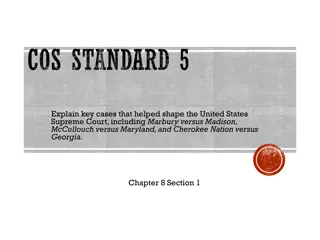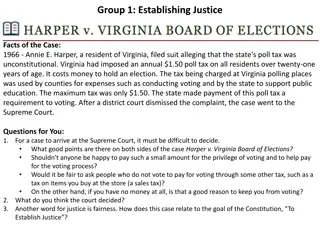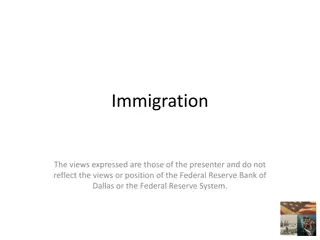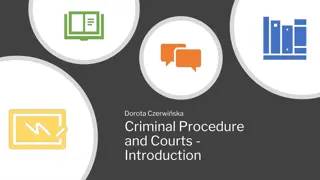Key Decisions on Criminal and Immigration Law by the U.S. Supreme Court 2020-2021 Term
This summary covers two significant cases from the 2020-2021 term of the United States Supreme Court. The first case, Edwards v. Vannoy, discusses the retroactive application of the Ramos jury-unanimity rule on federal collateral review. The second case, Jones v. Mississippi, addresses the sentencing requirements for juvenile offenders in light of the Miller and Montgomery rulings. The decisions of the Court and the implications for criminal and immigration law are explored.
Download Presentation

Please find below an Image/Link to download the presentation.
The content on the website is provided AS IS for your information and personal use only. It may not be sold, licensed, or shared on other websites without obtaining consent from the author.If you encounter any issues during the download, it is possible that the publisher has removed the file from their server.
You are allowed to download the files provided on this website for personal or commercial use, subject to the condition that they are used lawfully. All files are the property of their respective owners.
The content on the website is provided AS IS for your information and personal use only. It may not be sold, licensed, or shared on other websites without obtaining consent from the author.
E N D
Presentation Transcript
United States Supreme Court Criminal & Immigration Law Decisions of the 2020-2021 Term Michael B. Shapiro, J.D., Clinical Assistant Professor, Georgia State University and Peter Fenton, J.D., Faculty Emeritus, Kennesaw State University
Flying Fickle Finger of Fate Award, Part 1 3 Edwards v. Vannoy Kavanaugh majority, Thomas concurring, Gorsuch concurring, Kagan dissenting In 2007, a Louisiana jury found Edwards guilty of armed robbery, rape, and kidnapping. At the time, Louisiana law permitted non-unanimous jury verdicts if at least 10 of the 12 jurors found the defendant guilty. In Edwards s case, 11 of 12 jurors returned a guilty verdict as to some crimes, and 10 of 12 jurors returned a guilty verdict as to others. After Edwards s conviction became final on direct review, Edwards filed a federal habeas corpus petition, arguing that the non-unanimous jury verdict violated his constitutional right to a unanimous jury. The District Court rejected Edwards s claim as foreclosed by Apodaca v. Oregon, 406 U. S. 404 (1972), and the Fifth Circuit denied a certificate of appealability. While Edwards s petition for a writ of certiorari was pending, the Court repudiated Apodoca and held that a state jury must be unanimous to convict a criminal defendant of a serious offense. Ramos v. Louisiana, 590 U. S. ___ (2020). Edwards now argues that the Ramos jury-unanimity rule applies retroactively on federal collateral review. Held: The Ramos jury-unanimity rule does not apply retroactively on federal collateral review. Given the Court s numerous precedents holding that landmark and historic decisions announcing new rules of criminal procedure do not apply retroactively on federal collateral review, the Court acknowledges that the watershed exception is moribund and that no new rules of criminal procedure can satisfy the purported exception for watershed rules.
Flying Fickle Finger of Fate Award, Part 2 4 Jones v. Mississippi Kavanaugh majority, Thomas concurring, Sotomayor dissenting A Mississippi jury convicted Jones of murder for killing his grandfather when he was 15 years old and given a mandatory sentence of life without parole. Subsequently Miller v. Alabama, 567 U. S. 460, held that the Eighth Amendment permits a life-without-parole sentence for homicide when the defendant was under 18 only if the sentence is not mandatory and the sentencer therefore has discretion to impose a lesser punishment. The Mississippi Supreme Court ordered that Jones be resentenced in accordance with Miller and the trial judge determined that life without parole remained the appropriate sentence. Jones again appealed his sentence, citing both Miller and the then-recently decided case of Montgomery v. Louisiana, 577 U. S. 190, which held that Miller applied retroactively. Jones contended that, under Miller and Montgomery, a sentencer must make a separate factual finding that a murderer under 18 is permanently incorrigible before sentencing the offender to life without parole. The Mississippi Court of Appeals rejected Jones s argument. Held: Miller and Montgomery do not require the sentencer to make a separate factual finding of permanent incorrigibility before sentencing the defendant to life without parole because a discretionary sentencing system is both constitutionally necessary and constitutionally sufficient.
Immigration, Stop-Time Rule 5 Alaska v. Wright Per curiam An Alaska jury convicted Wright of 13 counts of sexual abuse of a minor. He finished serving his sentence in Alaska in 2016, and shortly thereafter moved to Tennessee. Once there, he failed to register as a sex offender as required by federal law, pleaded guilty to one count of failure to register and received a sentence of time served along with five years of supervised release. During the course of those federal proceedings, Wright filed a petition for a writ of habeas corpus in the United States District Court for the District of Alaska arguing that the Alaska Supreme Court had unreasonably applied clearly established federal law when it denied his Sixth Amendment claims and affirmed his state conviction and sentence. The District Court denied the motion on the threshold ground that Wright was not in custody pursuant to the judgment of a State court. 18 U.S.C. 2254(a). Held: Wright s state conviction served as a predicate for his federal conviction and thus did not render him in custody pursuant to the judgment of a State court under 2254(a).
Violent Felony Under Armed Career Criminal Act 6 Borden v. United States Kagan majority, Thomas concurring, Kavanaugh dissenting The Armed Career Criminal Act (ACCA) mandates a 15-year minimum sentence for persons found guilty of illegally possessing a firearm who have three or more prior convictions for a violent felony. An offense qualifies as a violent felony under ACCA s elements clause if it necessarily involves the use, attempted use, or threatened use of physical force against the person of another. 18 U. S. C. 924(e)(2)(B)(i). Petitioner Borden pleaded guilty to a felon-in-possession charge, and the Government sought an enhanced sentence under ACCA. One of the three convictions alleged as predicates was for reck-less aggravated assault in violation of Tennessee law. Borden argued that this offense is not a violent felony under ACCA s elements clause because a mental state of recklessness suffices for conviction. In his view, only purposeful or knowing conduct satisfies the clause s demand for the use of force against the person of another. The District Court disagreed and sentenced Borden as a career offender. The Sixth Circuit affirmed. Held: The judgment is reversed, and the case is remanded.
Warrantless Search of the Home 7 Caniglia v. Strom, et al. Thomas unanimous, Roberts concurring, Alito concurring, Kavanaugh concurring Caniglia had an argument with his wife and placed a handgun on the dining room table and asked his wife to shoot [him] and get it over with. His wife left the home and the next morning was unable to reach her husband, so she called the police to request a welfare check. The officers called an ambulance based on the belief that Caniglia posed a risk to himself or others. Caniglia agreed to go to the hospital for a psychiatric evaluation on the condition that the officers not confiscate his firearms. Once Caniglia left, the officers seized his weapons. Caniglia sued, claiming that the officers had entered his home and seized him and his firearms without a warrant in violation of the Fourth Amendment. The District Court granted summary judgment to the officers and the First Circuit affirmed, extrapolating from the Court s decision in Cady v. Dombrowski, 413 U. S. 433 (1973), a theory that the officers removal of Caniglia and his firearms from his home was justified by a community caretaking exception to the warrant requirement. Held: Neither the holding nor logic of Cady justifies such warrantless searches and seizures in the home. Cady held that a warrantless search of an impounded vehicle for an unsecured firearm did not violate the Fourth Amendment. But searches of vehicles and homes are constitutionally different, as the Cady opinion repeatedly stressed. See also Justice Kavanaugh s concurring opinion on the grant of certiorari in Sanders v. United States, No. 20-6400, decided June 1, 2021
Fourth Amendment, Misdemeanor Warrantless Entry of the Home 8 Lange v. California Kagan majority, Kavanaugh concurring, Thomas concurring, Roberts concurring Lange drove by a California Highway Patrol officer while playing loud music and honking his horn. The officer followed Lange, later activating his overhead lights to signal that Lange should pull over. Rather than stopping, Lange drove a short distance to his driveway and entered his attached garage. The officer followed Lange into the garage. He questioned Lange and, after observing signs of intoxication, put him through field sobriety tests. A later blood test showed that Lange s blood-alcohol content was three times the legal limit. The State charged Lange with the misdemeanor of driving under the influence. Lange moved to suppress the evidence obtained after the officer entered his garage, arguing that the warrantless entry violated the Fourth Amendment. The Superior Court denied Lange s motion, and its appellate division affirmed. The California Court of Appeal also affirmed. It concluded that Lange s failure to pull over when the officer flashed his lights created probable cause to arrest Lange for the misdemeanor of failing to comply with a police signal. And it stated that Lange could not defeat an arrest begun in a public place by retreating into his home. The pursuit of a suspected misdemeanant, the court held, is always permissible under the exigent-circumstances exception to the warrant requirement. The California Supreme Court denied review. Held: Under the Fourth Amendment, pursuit of a fleeing misdemeanor suspect does not always that is, categorically justify a warrantless entry into a home. This is supported by both Fourth Amendment precedents and Common Law. Vacated and remanded.
Habeas Corpus, In Custody Requirement 9 Niz-Chavez v. Garland, Attorney General Gorsuch majority, Kavanaugh dissenting Nonpermanent resident aliens ordered removed from the United States under federal immigration law may be eligible for discretionary relief if, among other things, they can establish their continuous presence in the country for at least 10 years. 8 U. S. C. 1229b(b)(1). The stop-time rule included in the Illegal Immigration Reform and Immigrant Responsibility Act of 1996 (IIRIRA) provides that the period of continuous presence shall be deemed to end . . . when the alien is served a notice to appear in a removal proceeding under 1229a. 1229b(d)(1). A notice that omits any of this statutorily required information does not trigger the stop-time rule. See Pereira v. Sessions, 585 U. S. ___. The government ordered the removal of Niz-Chavez sending one document containing the charges and two months later sent a second document with the time and place of the hearing. The government contends that the two documents collectively specified all statutorily required information for a notice to appear such that Niz-Chavez s continuous presence in the country stopped when he was served with the second document. Held: A notice to appear sufficient to trigger the IIRIRA s stop-time rule is a single document containing all the information about an individual s removal hearing specified in 1229(a)(1).
Lawful Permanent Resident Status 10 Sanchez, et ux. v. Mayorkas, Secretary of Homeland Security, et al. Kagan unanimous Petitioner Sanchez is a citizen of El Salvador who challenges the denial of his application to become a lawful permanent resident (LPR) of the United States. Sanchez entered the United States unlawfully in 1997. In 2001, the Government granted him Temporary Pro-tected Status (TPS). In 2014, Sanchez applied under 1255 of the immigration laws to obtain LPR status. Section 1255 provides a way for a nonimmigrant a foreign national lawfully present in this country on a temporary basis to obtain an [a]djustment of status to LPR. 8 U. S. C. 1255. The United States Citizenship and Immigration Services determined Sanchez ineligible for LPR status because he entered the United States unlawfully. Sanchez successfully challenged that decision before the District Court, which reasoned that Sanchez s TPS required treating him as if he had been lawfully admit-ted to the country for purposes of his LPR application. The Third Circuit reversed, finding Sanchez s unlawful entry into the country precluded his eligibility for LPR status under 1255, notwithstanding his TPS. Held: A TPS recipient who entered the United States unlawfully is not eligible under 1255 for LPR status merely by dint of his TPS.
Eighth Amendment Conditions of Confinement 11 Taylor v. Riojas Per curiam, Thomas dissenting, Barrett took no part For six days correctional officers confined Taylor in a pair of shockingly unsanitary cells. The first was covered, nearly floor to ceiling, in massive amounts of feces : all over the floor, the ceiling, the window, the walls, and even packed inside the water faucet. Fearing that his food and water would be contaminated, Taylor did not eat or drink for nearly four days. Correctional officers then moved Taylor to a second, frigidly cold cell, which was equipped with only a clogged drain in the floor to dispose of bodily wastes. Taylor held his bladder for over 24 hours, but he eventually (and involuntarily) relieved himself, causing the drain to overflow and raw sewage to spill across the floor. Because the cell lacked a bunk, and because Taylor was confined without clothing, he was left to sleep naked in sewage. The Court of Appeals for the Fifth Circuit properly held that such conditions of confinement violate the Eighth Amendment s prohibition on cruel and unusual punishment. But, based on its assessment that [t]he law wasn t clearly established that prisoners couldn t be housed in cells teeming with human waste for only six days, the court concluded that the prison officials responsible for Taylor s confinement did not have fair warning that their specific acts were unconstitutional. Held: The Fifth Circuit erred in granting the officers qualified immunity on this basis. Confronted with the particularly egregious facts of this case, any reasonable officer should have realized that Taylor s conditions of confinement offended the Constitution.
Sentence Reduction Under the First Step Act 12 Terry v. United States Thomas majority, Sotomayor concurring Terry sought a sentence reduction for his 2008 crack cocaine conviction. In 1986, Congress established mandatory-minimum penalties for possession with intent to distribute cocaine. The first two carried mandatory minimum sentences based on drug quantity: a 5-year mandatory minimum (triggered by either 5 grams of crack cocaine or 500 grams of powder cocaine) and a 10-year mandatory minimum (triggered by either 50 grams of crack or 5 kilograms of powder). 100 Stat. 3207 2, 3207 3. The third penalty did not carry a mandatory minimum sentence, did not treat crack and powder cocaine offenses differently, and did not depend on drug quantity. Petitioner was subjected to this third penalty when he pleaded guilty in 2008 to possession with intent to distribute an unspecified amount of crack. The District Court determined that his offense involved about 4 grams of crack. Two years later, Congress passed the Fair Sentencing Act of 2010, adjusting the crack quantity thresholds, but Congress did not make this change retroactive until 2018 via the First Step Act. After that, Petitioner sought resentencing on the ground that he was convicted of a crack offense modified by the Fair Sentencing Act. The District Court denied his motion, and the Eleventh Circuit affirmed. Held: A crack offender is eligible for a sentence reduction under the First Step Act only if convicted of a crack offense that triggered a mandatory minimum sentence.
Fourth Amendment Physical Force is a Seizure 13 Torres v. Madrid, et al. Roberts majority, Gorsuch dissenting, Barrett took no part Madrid and Williamson, officers with the New Mexico State Police, arrived at an Albuquerque apartment complex to execute an arrest warrant and approached Torres, then standing near a vehicle. The officers attempted to speak with her as she got into the driver s seat. Believing the officers to be carjackers, Torres hit the gas to escape. The officers fired their service pistols 13 times to stop Torres, striking her twice. Police arrested her the next day. Torres later sought damages from the officers under 42 U.S.C. 1983 claiming the officers used excessive force against her and that the shooting constituted an unreasonable seizure under the Fourth Amendment. Affirming the District Court s grant of summary judgment to the officers, the Tenth Circuit held that a suspect s continued flight after being shot by police negates a Fourth Amendment excessive-force claim. Held: The application of physical force to the body of a person with intent to restrain is a seizure even if the person does not submit and is not subdued.
Uniform Code of Military Justice Statute of Limitations 14 United States v. Briggs Alito majority, Gorsuch concurring, Barrett took no part The Uniform Code of Military Justice (UCMJ) has long provided that a military offense, punishable by death, may be tried and punished at any time without limitation. 10 U. S. C. 843(a). Other military offenses are subject to a 5-year statute of limitations. 843(b). Respondents are three military service members, each convicted of rape. When they were charged, the UCMJ provided that rape could be punished by death. 920(a) (1994 ed.). Because this Court held that the Eighth Amendment forbids a death sentence for the rape of an adult woman, Coker v. Georgia, 433 U. S. 584, respondents argue that they could not, in fact, have been sentenced to death, and therefore the UCMJ s 5-year statute of limitations applies and bars their convictions. Agreeing, the Court of Appeals for the Armed Forces set aside their convictions. Held: Respondents prosecutions for rape under the UCMJ were timely.
Tribal Police Officers Authority to Detain & Search Non-Indians 15 United States v. Cooley Breyer unanimous, Alito concurring One night Officer James Saylor of the Crow Police Department approached a truck parked on United States Highway 212, a public right-of-way within the Crow Reservation and spoke to the driver, Cooley, observing that Cooley appeared to be non-native and had watery, bloodshot eyes, and noticing two semiautomatic rifles on the front seat. Fearing violence, Saylor ordered Cooley out of the truck and conducted a patdown search. Saylor also saw in the truck a glass pipe and a plastic bag that contained methamphetamine. Additional officers, including an officer with the federal Bureau of Indian Affairs, arrived on the scene in response to Saylor s call for assistance. Saylor was directed to seize all contraband in plain view, leading Saylor to discover more methamphetamine. Saylor took Cooley to the Crow Police Department where federal and local officers further questioned Cooley. Subsequently, a federal grand jury indicted Cooley on drug and gun offenses. The District Court granted Cooley s motion to suppress the drug evidence. The Ninth Circuit affirmed. It reasoned that a tribal police officer could stop (and hold for a reasonable time) a non-Indian suspect if the officer first tries to determine whether the suspect is non-Indian and, in the course of doing so, finds an apparent violation of state or federal law. The Ninth Circuit concluded that Saylor had failed to make that initial determination here. Held: A tribal police officer has authority to detain temporarily and to search non-Indian persons traveling on public rights-of-way running through a reservation for potential violations of state or federal law.
Computer Fraud and Abuse Act of 1986 16 Van Buren v. United Barrett majority, Thomas dissenting Former Georgia police sergeant Van Buren used his patrol-car computer to access a law enforcement database to retrieve information about a particular license plate number in exchange for money, violating department policy against obtaining database information for non-law-enforcement purposes. His actions were part of a Federal Bureau of Investigation sting operation. Van Buren was charged with a felony violation of the Computer Fraud and Abuse Act of 1986 (CFAA), which subjects to criminal liability anyone who intentionally accesses a computer without authorization or exceeds authorized access. 18 U. S. C. 1030(a)(2). The term exceeds authorized access is defined to mean to access a computer with authorization and to use such access to obtain or alter information in the computer that the accesser is not entitled so to obtain or alter. 1030(e)(6). A jury convicted Van Buren, and the District Court sentenced him to 18 months in prison. Van Buren appealed to the Eleventh Circuit, arguing that the exceeds authorized access clause applies only to those who obtain information to which their computer access does not extend, not to those who misuse access that they otherwise have. Consistent with Eleventh Circuit precedent, the panel held that Van Buren had violated the CFAA. Held: An individual exceeds authorized access when he accesses a computer with authorization but then obtains information located in particular areas of the computer such as files, folders, or databases that are off-limits to him.
Cases to Watch in the 2021-2022 Term 17 United States v. Tsarnaev (First Circuit Court of Appeals) Dzhokar and Tamerlan Tsarnaev detonated two bombs during the Boston Marathon resulting in 3 deaths and 250 injuries. At trial Dzhokhar admitted to setting the bombs but alleged Tamerlan intimidated him into committing the acts. Dzhokhar appealed his convictions claiming an impartial jury was impossible due to pretrial publicity and that the trial judge erred by denying the defense request for content-specific questions during voir dire. Question(s) presented: Whether the court of appeals erred in concluding that respondent s capital sentences must be vacated on the ground that the district court, during its 21-day voir dire, did not ask each prospective juror for a specific accounting of the pretrial media coverage that he or she had read, heard, or seen about respondent s case. Whether the district court committed reversible error at the penalty phase of respondent's trial by excluding evidence that respondent's older brother was allegedly involved in different crimes two years before the offenses for which respondent was convicted.
Cases to Watch in the 2021-2022 Term 18 New York State Rifle & Pistol Association, Inc. v. Corlett (Second Circuit Court of Appeals) Nash and Koch applied for New York licenses to carry firearms outside the home. The licensing officer denied their requests after determining that, under New York law, they had failed to show proper cause to carry a firearm in public for the purpose of self-defense, because [they] did not demonstrate a special need for self-defense that distinguished [them] from the general public. Nash, Koch and the New York State Rifle & Pistol Association argue that the Second Amendment protects the right to carry a firearm outside the house for self-defense, and they say that the state abridges a right that the Constitution guarantees to all the people when carrying a firearm for self-defense is deemed a crime unless one can preemptively convince a state official that she enjoys an especially good reason for wanting to do so. Question(s) presented: Whether the state of New York's denial of petitioners' applications for concealed-carry licenses for self-defense violated the Second Amendment?
Cases to Watch in the 2021-2022 Term 19 Thompson v. Clark (Second Circuit Court of Appeals) Investigating a report of child abuse, police over Thompson s refusal entered his residence without a warrant. Thompson was arrested for obstruction and resisting arrests, but the charges were ultimately dismissed. Thompson brought an action for deprivation of his rights pursuant to 42 U.S.C. 1983. Question(s) presented: Whether the rule that a plaintiff must await favorable termination before bringing a Section 1983 action alleging unreasonable seizure pursuant to legal process requires the plaintiff to show that the criminal proceeding against him has 'formally ended in a manner not inconsistent with his innocence,' Laskar v. Hurd, 972 F.3d 1278, 1293 (11th Cir. 2020), or that the proceeding 'ended in a manner that affirmatively indicates his innocence,' Lanning v. City of Glens Falls, 908 F.3d 19, 22 (2d Cir. 2018); see also Laskar, 972 F.3d at 1293 (acknowledging 7-1 circuit conflict). Where a Section 1983 plaintiff brings a Fourth Amendment claim for unlawful warrantless entry of his home and the government pursues a justification of exigent circumstances, does the government have the burden to prove exigency existed (as the Third, Sixth, Ninth and Tenth Circuits have held), or does the plaintiff have to prove its non-existence (as the Second, Seventh and Eighth Circuits have held).
Cases to Watch in the 2021-2022 Term 20 Wooden v. United States (Sixth Circuit Court of Appeals) While searching for a fugitive, officers were granted entry into Wooden s home. The officers knew Wooden was a convicted felon and saw him retrieve a rifle which he put down upon order. Officers searched and found two other weapons. Question(s) presented: Did the warrantless entry and search of petitioner's home violate his Fourth Amendment right to be free from illegal search and seizure? Did the Sixth Circuit err by expanding the scope of 18 U.S.C. 924(e)(1) in the absence of clear statutory definition with regard to the vague term 'committed on occasions different from one another ?
Cases to Watch in the 2021-2022 Term 21 Brown v. Davenport (Sixth Circuit Court of Appeals) In 2008, Ervine Davenport was convicted of first-degree murder following a jury trial in a Michigan state court. During the trial, he was visibly shackled at his feet, waist, and one wrist. He appealed his conviction in state court on a number of grounds, including that he was denied due process by being required to wear shackles at his trial. Question(s) presented: May a federal habeas court grant relief based solely on its conclusion that the Brecht v. Abrahmson test is satisfied, as the Sixth Circuit held, or must the court also find that the state court s Chapman v. California application was unreasonable under 2254(d)(1), as the Second, Third, Seventh, Ninth, and Tenth Circuits have held?
Cases to Watch in the 2021-2022 Term 22 Hemphill v. New York (New York Court of Appeals) Hemphill was tried in a New York state court for second-degree murder in the shooting death of a child. At trial, Hemphill s attorney introduced evidence of a different shooter. The trial court ruled that this defense opened the door to the prosecution presenting rebuttal evidence, which included testimony given at prior legal proceedings that would typically be barred by the Sixth Amendment s Confrontation Clause. Question(s) presented: Whether, or under what circumstances, a criminal defendant who opens the door to responsive evidence also forfeits his right to exclude evidence otherwise barred by the Confrontation Clause.
Thanks! Any questions? You can find us at mshapiro5@gsu.edu & pfenton@kennesaw.edu 23
